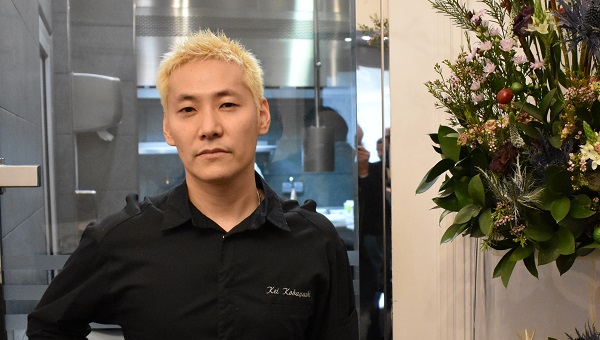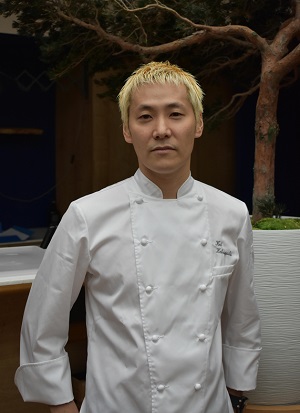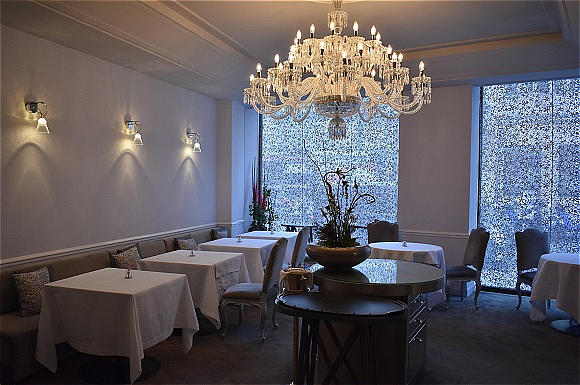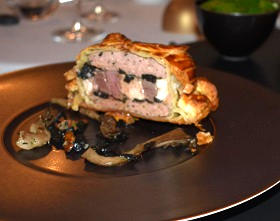
Kei Kobayashi © GLKraut.
Editor’s note: This article was written while Kei held two Michelin star and its chef was aspiring to a third. In 2020, one year after the publication of this article, Kei received its third Michelin star.
***
What do Alain Ducasse, Alain Passard, Pierre Gagnière, Anne-Sophie Pic, Gilles Goujon and Jean-François Piège have in common? If you answered that they are all masters of French high gastronomy then you’d be half right. The other half? They also have very French names.
Unlike Kei Kobayashi. Yet Kei Kobayashi is also a master of French high gastronomy, working the kitchen and operating his eponymous restaurant Kei. If his name sounded more French then perhaps this exceptional chef would have more American and British clients. As it is, he has a faithful French clientele, Japanese clients and a smattering of other well-informed international gastronomes.
Mastering the art of French cooking isn’t a question of nationality, as Julia Child taught us, but mastering the heights of French gastronomy has been a fairly passport-driven affair… until recently. Ten or twenty years ago, a chef from overseas would train in France for five, even ten, years then return home to, say, Japan to wow his compatriots and pursue his career there. But increasingly some high-caliber chefs from abroad choose to pursue their careers in France.
Kei Kobayashi, for example.
“I want to do that!”
Born in 1977, Kobayashi speaks of a vertical path from his childhood in Nagano, Japan, to the stature of a 2-star Michelin chef in Paris and about his ambitions. His father was a traditional chef of precise slicing in Japan. At age 15, the younger Kobayashi saw a documentary on TV featuring French chef Alain Chapel (3-star Michelin) in the kitchen. On the screen the chef worked with flare, fire and flourish as he’d never seen in his father’s kitchen. He speaks of it as a revelation. “I told myself, ‘I want to do that!’”

Having started his training in Japan, he arrived in France at the age of 21 intent on discovering, learning, practicing and climbing to the heights of French gastronomy. (Somehow along the way he also picked up the notion that French chefs are blond and so began dying his hair.)
A culinary Tour de France followed, during which time he worked with and learned from stellar chefs in Paris, Languedoc, Provence and Alsace. He opened Kei near Les Halles in 2011, received his first Michelin star a year later and a second in 2017.
Fifteen to twenty years ago, meeting a chef who had turned his back on the world of high gastronomy to focus on more accessible culinary offerings was refreshing. Now it’s refreshing to meet unabashedly facing the summit. From the moment he opened Kei, he said, he was aiming (and pushing his staff to aim) for three stars. That’s something few chefs think or admit.

The Setting
At first glance the 30-seat room of Kei seems mildly ascetic, despite the glitter and glow of the Saint Louis chandelier. But before long the off-white walls reveal a hint of lavender and one notices the crown molding and discreet French flourishes. At lunchtime, the glassy the white cut-outs on the wall-length picture window facing the street combined with the radiance of the chandelier and of the sconces reminds me of the comfort of a dreamy afternoon on a snowy day.
Distinguishing Japanese touches from French touches in the décor, the tableware and the succession of dishes is a table game that one inevitably plays… given the name Kei Kobayashi. The dishware and cutlery clearly present a marriage of cultures. But once settled into the meal one finds that Kobayashi’s cuisine—presented exclusively through tasting menus—is not a game of cross-cultural references but a hike to the heights of French gastronomy. True, along with products from France there may be some from Japan, Italy, Scotland and elsewhere. But it isn’t the Frenchness of the product that makes Kobayoshi’s cuisine French. It’s the intensity of focus on those products.
We’ve all had exquisite tasting menus that can be showy. I do enjoy the occasional gastronomic culinary Vaudeville, but Kobayashi’s cuisine is more subtle than that.
The Meal
There’s nearly something sacred about the progression through the meal, though without ritual or ceremony. Asked about the rhythm of a tasting menu, Kobayashi says that there is no single path. Instead, he speaks of the meal as a living construction, based on quality products, whether simple or noble, forming a menu that will change but should always feel complete. Our table’s 7-step tasting menu nevertheless evolved in nearly classic French rhythm from shrimp to vegetables and smoked salmon to quail risotto to smoked langoustine, culminating in line-caught sea-bass, before easing down with cheese and sorbet/dessert.

The menu is largely based on fish and seafood, from Carabineros prawn tartare with a smoked eel emulsion and a nip of Schrenki caviar to a direct this-is-the-real-taste-of-line-caught-sea bass whose sensuality retains an enticing coarseness thanks to his treatment of scales that have been left on.
The prawn of our menu was followed by the most seductive and deceptively simple of our seven dishes: a salad of raw and cooked vegetables, herbs, flowers, crumbled olives, a citrusy arugula mousse and a slice of smoked salmon from Scotland, all to be delicately turned and mingled by the client before tasting. It’s a celestial dish—the first time that I’ve ever thought of a mixed salad as a delicacy. The quail risotto with white Alba truffle, a Perigueux sauce and parmesan then tastefully brought us back to earth. A hay-steamed langoustine married with shitaki mushrooms appeared to be an attempt to return to the salad’s state of grace, but was for me the least remarkable of the dishes.

Beyond the tasting menus, diners can also add a course of l’oreiller de la belle Aurore, a pâté (in this case of game and fowl) baked in a savory pastry. It’s a highly crafted dish of rustic elegance that has in various shapes and forms been a staple of French culinary tradition for over 200 years. It was a signature of Gérard Besson, Kobayashi’s predecessor at this address. It’s placement on the menu is a sign of Kobayashi’s homage to and devotion to the heritage of French gastronomy that he carries forward.
A French chef
Reducing the Kei dining experience to cross-cultural analysis is to ignore the richness sought at the height of French gastronomy. The height for Kobayashi is one star away. Michelin-bashing has no place in his culinary world. In order to merit the third star, he says, he’s aware that he has to develop his own originality while ensuring flawlessness from start to finish and from kitchen to dining room.
No need to wait for that third star to put Kei on your culinary map. And don’t imagine that a Japanese name makes Kobayashi’s gastronomy any less French. Whatever passport he holds, think of Kei Kobayashi as an exceptional French chef.
Kei, 5 rue Coque Héron, 1st arr, just west of Les Halles. Metro Louvre-Rivoli or Sentier or Etienne Marcel. Tel. 01 42 33 14 74. Closed Sunday, Monday and lunch Thursday. The typical lunch menu is served in five steps or an extensive tasting in 9 steps. There’s also a 9-step “prestige” menu that includes additional choice items. See pricing for various lunch and dinner tasting menus here.
© 2019, Gary Lee Kraut.

